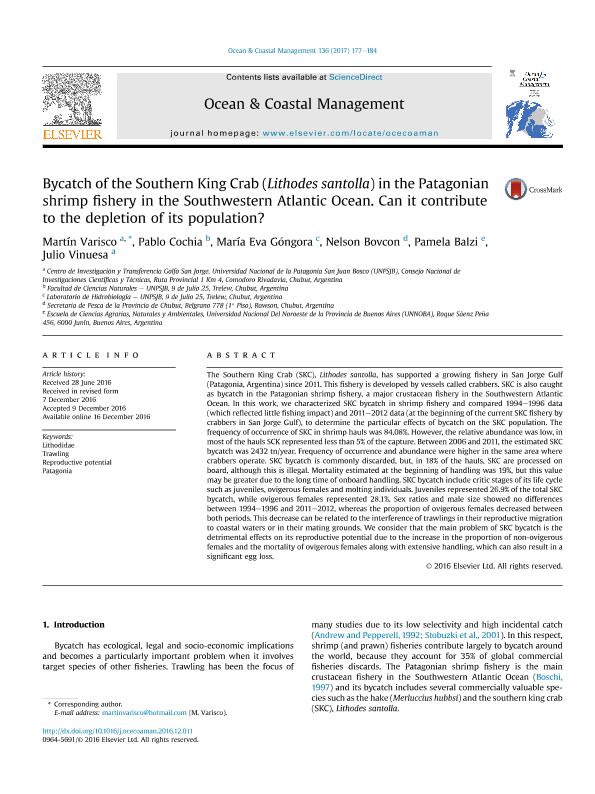Artículo
Bycatch of the Southern King Crab (Lithodes santolla) in the Patagonian shrimp fishery in the Southwestern Atlantic Ocean. Can it contribute to the depletion of its population?
Varisco, Martin Alejandro ; Cochia, Pablo; Góngora, María Eva
; Cochia, Pablo; Góngora, María Eva ; Bovcon, Nelson Darío
; Bovcon, Nelson Darío ; Balzi, Pamela; Vinuesa, Julio Hector
; Balzi, Pamela; Vinuesa, Julio Hector
 ; Cochia, Pablo; Góngora, María Eva
; Cochia, Pablo; Góngora, María Eva ; Bovcon, Nelson Darío
; Bovcon, Nelson Darío ; Balzi, Pamela; Vinuesa, Julio Hector
; Balzi, Pamela; Vinuesa, Julio Hector
Fecha de publicación:
02/2017
Editorial:
Elsevier
Revista:
Ocean & Coastal Management
ISSN:
0964-5691
Idioma:
Inglés
Tipo de recurso:
Artículo publicado
Clasificación temática:
Resumen
The Southern King Crab (SKC), Lithodes santolla, has supported a growing fishery in San Jorge Gulf (Patagonia, Argentina) since 2011. This fishery is developed by vessels called crabbers. SKC is also caught as bycatch in the Patagonian shrimp fishery, a major crustacean fishery in the Southwestern Atlantic Ocean. In this work, we characterized SKC bycatch in shrimp fishery and compared 1994–1996 data (which reflected little fishing impact) and 2011–2012 data (at the beginning of the current SKC fishery by crabbers in San Jorge Gulf), to determine the particular effects of bycatch on the SKC population. The frequency of occurrence of SKC in shrimp hauls was 84.08%. However, the relative abundance was low, in most of the hauls SCK represented less than 5% of the capture. Between 2006 and 2011, the estimated SKC bycatch was 2432 tn/year. Frequency of occurrence and abundance were higher in the same area where crabbers operate. SKC bycatch is commonly discarded, but, in 18% of the hauls, SKC are processed on board, although this is illegal. Mortality estimated at the beginning of handling was 19%, but this value may be greater due to the long time of onboard handling. SKC bycatch include critic stages of its life cycle such as juveniles, ovigerous females and molting individuals. Juveniles represented 26.9% of the total SKC bycatch, while ovigerous females represented 28.1%. Sex ratios and male size showed no differences between 1994–1996 and 2011–2012, whereas the proportion of ovigerous females decreased between both periods. This decrease can be related to the interference of trawlings in their reproductive migration to coastal waters or in their mating grounds. We consider that the main problem of SKC bycatch is the detrimental effects on its reproductive potential due to the increase in the proportion of non-ovigerous females and the mortality of ovigerous females along with extensive handling, which can also result in a significant egg loss.
Palabras clave:
Lithodidae
,
Patagonia
,
Reproductive Potential
,
Trawling
Archivos asociados
Licencia
Identificadores
Colecciones
Articulos(SEDE CENTRAL)
Articulos de SEDE CENTRAL
Articulos de SEDE CENTRAL
Citación
Varisco, Martin Alejandro; Cochia, Pablo; Góngora, María Eva; Bovcon, Nelson Darío; Balzi, Pamela; et al.; Bycatch of the Southern King Crab (Lithodes santolla) in the Patagonian shrimp fishery in the Southwestern Atlantic Ocean. Can it contribute to the depletion of its population?; Elsevier; Ocean & Coastal Management; 136; 2-2017; 177-184
Compartir
Altmétricas



